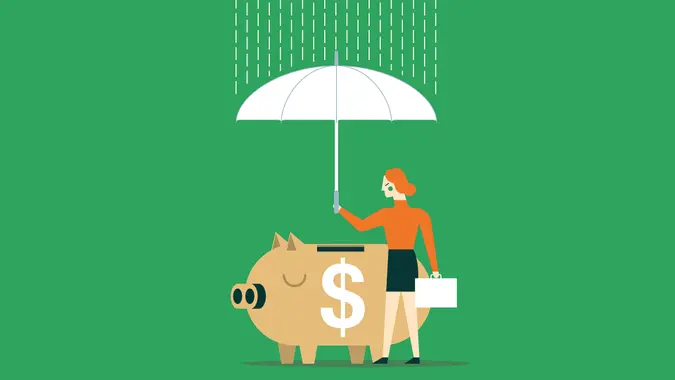4 Alternatives To Dipping Into Retirement Funds in Case of an Emergency

Commitment to Our Readers
GOBankingRates' editorial team is committed to bringing you unbiased reviews and information. We use data-driven methodologies to evaluate financial products and services - our reviews and ratings are not influenced by advertisers. You can read more about our editorial guidelines and our products and services review methodology.

20 Years
Helping You Live Richer

Reviewed
by Experts

Trusted by
Millions of Readers
One of the cardinal rules of personal finance is to save consistently for retirement and forget those dollars exist until you need them in your golden years — even in the case of emergencies. Early retirement fund withdrawals trigger tax payments and IRS penalties while shrinking your nest egg and hampering its ability to compound returns.
Build an Emergency Fund Before the Emergency Arrives
Leaky roofs, blown alternators and dead furnaces happen — and fixing or replacing them isn’t cheap. The primary options for managing such emergencies are going into credit card debt or even taking out toxic payday loans, dipping into your retirement fund or — the best, safest and easiest option by far — using your emergency fund to cover the cost.
Experts typically recommend saving three to six months’ worth of income in case of a job loss, but the Consumer Financial Protection Bureau suggests adopting a something-is-better-than-nothing mentality while taking the following steps.
- Set ambitious but achievable goals
- Use automatic transfers or another system for ensuring regular, consistent contributions
- Monitor your progress regularly
- Increase contributions when your income rises
- Define “emergency” to make sure you avoid dipping in for wants
Apply For a Balance Transfer Card
If the emergency has already barged into your life and you don’t have the savings reserves to manage it, those with good credit have a good option.
Balance transfer credit cards offer 0% introductory APRs — but you don’t actually have to transfer a balance to take advantage. If you’re approved, your card issuer will send you checks and/or instructions for electronic transfers that you can use for just about anything — including depositing the available funds into your own bank account.
Beware: When the introductory period ends, you’re on the hook for the whole tab and sky-high, revolving credit card interest will start compounding immediately. But if you play it right and stick to a payback plan, you can buy yourself more than a year to eliminate the debt without paying a single penny in finance charges. In essence, it’s a free loan.
Tap Your Home Equity
If you own a home, you can access the wealth you have tied up in what is probably your most valuable asset. Home equity loans — which let you borrow against the equity you’ve built — are among the cheapest ways to borrow money for emergencies.
Rates vary by lender and borrower, but Forbes says the best options currently offer APRs in the mid-sevens. However, the Fed just announced an aggressive 0.5% rate cut and indicated more reductions are likely in the near future — and that means better loan terms for you.
Take Out a Personal Loan
Personal loans are more expensive than home equity loans — Forbes says the best-qualified borrowers should expect to pay 9% or 10%. While those rates are higher than home equity loans, they’re much cheaper than credit cards, and they offer fixed, flexible and predictable repayment terms that let you know exactly what you’ll have to pay each month and for how many months you’ll have to pay.
Here, too, the Fed’s action should make most personal loans cheaper in the coming weeks.
 Written by
Written by  Edited by
Edited by 

























